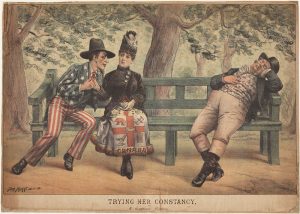4.8 Summary

Macdonald and Laurier were 19th century, Victorian-era men. They witnessed industrialization, imperialism, and urbanization first-hand. Most of Laurier’s time in office occurred during the Edwardian years; a period that was marked by a rising middle class, and renewed optimism in social progress and equality, the arts, and technological transformation. Macdonald died too soon to see motion pictures and automobiles; he missed, too, the bicycle craze and the Suffragettes. He also missed the most compelling signs of Britain’s economic slide against its competitors, including the United States and, significantly, Germany. Laurier wasn’t too late into politics to see the old western frontier, but by the time he was prime minister the days of the Red River cart and the bison were fading or gone. The importance of the Edwardian era is that, after 64 years of one monarch and the Pax Britannica — the era of relative peace associated with British global power — its start in 1901 signalled the beginning of a new century and renewed possibilities. In the midst of the prosperity and self-confidence that Canada enjoyed in the years up to 1912, one can see the consolidation of many of the ideas and practices that defined the country for the century to come. The aspiration to be something more than a colonial appendage was one theme that would come out of these years and would strongly influence politicians and writers in the generations ahead.
Edward VII died in 1910 and Laurier was toppled the very next year. The economic boom times would come to a grinding halt beginning in 1912. What lay ahead was much worse.
Key Terms
anticlerical, anticlericalism: Someone who believes that the separation of church and state in civic life is essential for the well-being of a successful democratic society.
branch plants: Typically American-owned companies that avoided tariff barriers by establishing plants on the Canadian side of the border.
Canada First: Established in 1868, an English-Canadian nationalist movement.
confessional schools: Religious schools run by Catholic or Protestant denominations.
dualism: The idea that Canada could or should construct its culture and institutions around two cultures, French and English. In contrast with unification (which favours one culture) and pluralism or multiculturalism in which French in particular is at risk of becoming a minority culture.
Manitoba schools question: In 1890 the provincial government turned its back on commitments in the Manitoba Act (1870) to provide a dual — French and English — system of education, a move that was stimulated by declining French and Catholic populations. The Privy Council determined (twice) that the federal government had the power to reverse this decision. In opposition, Wilfrid Laurier blocked Ottawa’s attempt at disallowance; in government he negotiated a compromise with Manitoba.
Orange: Refers to the Orange Order, its members, and its values; a Protestant fraternal association with roots in Ireland; marked by a strong antipathy for Catholics and Catholicism, as well as a fierce loyalty to the Crown. Supported Protestant immigrants and made use of violence and political networks to achieve its ends.
pragmatic: In politics, the focus on existing conditions rather than ideological considerations or objectives. Also called realpolitik.
preferential tariff: Charges (a tax) added to imported goods so as to make their sale price higher than domestic goods and, thus, make domestic goods more competitive; some trade partners are less discriminated (they are “preferred”) over others.
Rouge: Also Parti rouge. Political party and tradition in Quebec; established in the 1840s, it became increasing more pro-secular, anticlerical, and opposed to hereditary privilege; opposed to Confederation, embraced provincial rights; after 1867, merged with the Clear Grits to form the Liberal Party.
Short Answer Exercises
- What was dualism? Where were its weaknesses most exposed?
- Account for the success of Macdonald’s Conservatives to 1896.
- What role was played by the Catholic Church in the politics of Quebec and Canada?
- What was the relationship between the Liberal Party and the tariff issue?
- What were the most divisive issues faced by Laurier’s administration?
- What were the respective positions of imperialists and nationalists in pre-WWI Canada?
- In what ways did these two visions of Canada make the country almost ungovernable?
- In what ways had Canada changed politically between 1867 and 1914?
Suggested Readings
Backhouse, Constance. “’Don’t You Bully Me … Justice I Want If There is Justice to Be Had’: The Rape of Mary Ann Burton, London, Ontario, 1907,” People and Place: Historical Influences on Legal Culture, eds. Jon Swainger and Constance Backhouse (Vancouver: University of British Columbia Press, 2003): 60-94.
Beaulieu, Eugene and J. C. Herbert Emery, “Pork Packers, Reciprocity, and Laurier’s Defeat in the 1911 Canadian General Election,” The Journal of Economic History, 61, no. 4 (Dec 2001): 1083-1101.
Lord, Kathleen. “Representing Crime in Words, Images, and Song: Exploring Primary Sources in the Murder of Mélina Massé, Montreal, 1895,” Histoire Sociale/Social History, 43, no. 86 (Novembre-November 2010): 249-55.
Martin, Ged. “John A. Macdonald and the Bottle,” Journal of Canadian Studies, 40, no. 3 (Fall 2006): 162-85.
Miller, Carman. “Framing Canada’s Great War: a case for including the Boer War,” Journal of Transatlantic Studies, 6, no. 1 (April 2008): 3-21.
Attributions
Figure 4.21
Trying Her Constancy, or, a dangerous flirtation (Online MIKAN no.2838080) by Library and Archives Canada, Acc. No. R9266-3552 / Peter Winkworth Collection of Canadiana is in the public domain.

